New Mars Forums
You are not logged in.
- Topics: Active | Unanswered
Announcement
#351 2008-05-17 15:58:08
- cIclops
- Member
- Registered: 2005-06-16
- Posts: 3,230
Re: Orion (CEV / SM) - status
Aerojet Completes Early Risk Reduction Engine Testing
SACRAMENTO, Calif., May 13, 2008 – Aerojet, a GenCorp (NYSE: GY) company, successfully completed a hot-fire testing program of the Orion crew module 120-pound thrust mono-propellant engine to demonstrate operation at expected Orion flight conditions. Because this thruster was designed to operate in space, there was concern that performance would be significantly degraded as the thruster operated in an atmospheric environment as the crew module returned to earth. This sea-level test program included thermal cycle testing, with more than 20 thermal cycles and over 450 pulses as well as two mission duty cycle demonstrations. The test results indicate that the MR-104G will meet the required Orion operating conditions and is an important step in elimination of this risk. “A key tenet of the Constellation program is to identify and eliminate risk as early as possible. This testing validates the selection of Aerojet’s MR-104G engine for the Orion program,” said Julie Van Kleeck, vice president of Space Systems.
[color=darkred]Let's go to Mars and far beyond - triple NASA's budget ![/color] [url=irc://freenode#space] #space channel !! [/url] [url=http://www.youtube.com/user/c1cl0ps] - videos !!![/url]
Offline
Like button can go here
#352 2011-11-25 23:00:30
- SpaceNut
- Administrator
- From: New Hampshire
- Registered: 2004-07-22
- Posts: 30,271
Re: Orion (CEV / SM) - status
Much has happened with the cancellation of the constellation program the broadening of cots, private company funding and even the redirection of not going to the moon for the Orion capsule.
The capsule is now the MPVC and also on the same stage is the CST-100 commercial human spacecraft.
Boeing Tapping Heritage Programs for Space Taxi Design all to get around the US buying from Russia to fly astronauts to the space station, at a cost of more than $60 million per person...
NASA currently is investing $316.2 million among four firms, including Boeing, for development of space taxis and related technologies. NASA, which is paying Boeing when it achieves predetermined milestones, agreed to add $20.6 million if Boeing met three additional milestones, bringing the potential value of its present contract up to $112.9 million. The company previously received $18 million under the first phase of NASA’s Commercial Crew Development program. NASA had requested $850 million for the next phase of the program, but was allotted $406 million for the fiscal year that began Oct. 1. Managers have not yet said how the reduced funding would impact the number of contractors or scope of work.
The destination for the taxi is the ISS with a planned useage until 2020....
The goal is to get to a preliminary design review in February or March 2012. Depending on funding, the company plans to have a launch pad abort test in the first half of 2014; an orbital flight test in the first half of 2015; an ascent abort test in mid-2015; and a crew flight test in the second half of 2015.
“The baseline plan is to be crew transport capable by the close of 2015,” Hardison said.
Offline
Like button can go here
#353 2012-02-13 21:02:29
- SpaceNut
- Administrator
- From: New Hampshire
- Registered: 2004-07-22
- Posts: 30,271
Re: Orion (CEV / SM) - status
The proposed budget would give NASA $17.71 billion, about $60 million less than the agency received for 2012. With the winner a continued funding of the Orion.....
Offline
Like button can go here
#354 2012-11-21 11:20:32
- cIclops
- Member
- Registered: 2005-06-16
- Posts: 3,230
Re: Orion (CEV / SM) - status
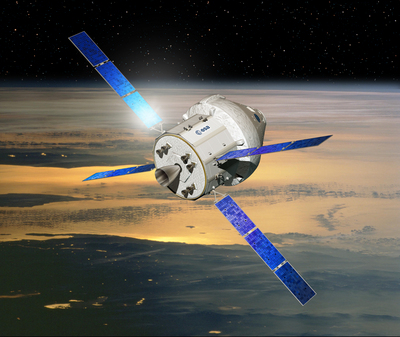
Proposal for a Multi-Purpose Crew Vehicle-Service Module (MPCV-SM)
At long last some good news and a new direction announced today ....
Ministers gave the green light for Europe to provide the service module of NASA’s new Orion Multipurpose Crew Vehicle (MPCV) as an in-kind contribution for ISS operations for 2017–20. This decision is strategically important for Europe as it will enable a cooperation between ESA and NASA on the future human space transportation system.
And yes it's true!
European Ministers decide to invest in space (paragraph 5)
Last edited by cIclops (2012-11-21 11:26:23)
[color=darkred]Let's go to Mars and far beyond - triple NASA's budget ![/color] [url=irc://freenode#space] #space channel !! [/url] [url=http://www.youtube.com/user/c1cl0ps] - videos !!![/url]
Offline
Like button can go here
#355 2012-11-21 19:41:11
- RobertDyck
- Moderator
- From: Winnipeg, Canada
- Registered: 2002-08-20
- Posts: 8,353
- Website
Re: Orion (CEV / SM) - status
Very very odd. ESA developed the Ariane 5 rocket specifically to lift a crewed spacecraft to ISS. But after the rocket was developed, they cancelled the spacecraft. Then they developed the ATV, but cargo only. There have been proposals to convert that to a crewed vehicle, but every effort was cancelled. When NASA cancelled the X-38, ESA proposed paying for it and ensuring it can launch on Ariane 5. But European politicians said buying an American vehicle would defeat the point. Now they want to participate with Boeing & Lockheed-Martin with Orion?
I supposed they could adapt the service module from ATV, but still I find it very very odd.
Offline
Like button can go here
#356 2012-11-21 23:14:10
- cIclops
- Member
- Registered: 2005-06-16
- Posts: 3,230
Re: Orion (CEV / SM) - status
I supposed they could adapt the service module from ATV, but still I find it very very odd.
Exactly. The proposal is to base the service module on the ATV. ESA have offered this to offset their share of ISS common operating costs. Germany and the UK supported this and won approval during the ESA council meeting this week. This will give ESA a seat on Orion for future deep space missions.
[color=darkred]Let's go to Mars and far beyond - triple NASA's budget ![/color] [url=irc://freenode#space] #space channel !! [/url] [url=http://www.youtube.com/user/c1cl0ps] - videos !!![/url]
Offline
Like button can go here
#357 2013-03-14 07:28:42
- cIclops
- Member
- Registered: 2005-06-16
- Posts: 3,230
Re: Orion (CEV / SM) - status

NASA On Course to Launch Orion Flight Test - 28 Feb 2013
The first spacecraft NASA has designed to fly astronauts beyond Earth orbit since the Apollo era is well on its way to making a flight test next year, agency officials said Wednesday. The mission is planned for launch in September 2014, and will see an Orion capsule orbit Earth without a crew and return through the atmosphere at speeds unseen since astronauts last returned from the moon in 1972.
"It's a key element of our overall plan to get humans beyond Earth orbit as quickly as we can," said Dan Dumbacher, deputy associate administrator for NASA's Exploration Systems Development Division.
[color=darkred]Let's go to Mars and far beyond - triple NASA's budget ![/color] [url=irc://freenode#space] #space channel !! [/url] [url=http://www.youtube.com/user/c1cl0ps] - videos !!![/url]
Offline
Like button can go here
#358 2013-03-14 19:50:09
- SpaceNut
- Administrator
- From: New Hampshire
- Registered: 2004-07-22
- Posts: 30,271
Re: Orion (CEV / SM) - status
From the image we are getting a test of the heat shield and recovery system but not much else as this is quite the frankenstine launch vehicle...
Offline
Like button can go here
#359 2013-12-07 14:13:22
- SpaceNut
- Administrator
- From: New Hampshire
- Registered: 2004-07-22
- Posts: 30,271
Re: Orion (CEV / SM) - status
The orion heatsield is being delivered for the test launch built to withstand more than 4,000 degrees Fahrenheit.
Heat shield delivered for NASA’s Orion spacecraft
In January 2012, Lockheed Martin contractors at the Waterton Facility near Denver built the shield’s structure, a titanium skeleton and carbon fiber skin. Ablative material — fireproof material used to protect spacecraft entering and leaving the Earth’s atmosphere — was then added at Textron Defense Systems in Boston.
When the Orion launches on its first unmanned test flight in September, the heat shield will be in place for the two-orbit journey at an altitude of about 3,600 miles.
Offline
Like button can go here
#360 2013-12-08 10:07:53
- GW Johnson
- Member
- From: McGregor, Texas USA
- Registered: 2011-12-04
- Posts: 6,125
- Website
Re: Orion (CEV / SM) - status
"Withstanding a temperature" almost has no meaning at Earth entry conditions. That's a concept from earthly furnace and engine experiences. A rough rule of thumb for entry says the heating rates behave as if the air temperature in degrees K is numerically equal to the speed in meters per second. It's not really that high, it's ionized instead, but the energy content of the air behaves like that (the more energetic the "air", the more it overheats whatever it touches).
It's in an afterburner or a ramjet combustor that you actually "withstand" a real gas temperature of 4000 F. That's a different kind of heat transfer problem entirely, more like what's actually in the heat transfer textbooks. That entry stuff is a specialty application that really isn't in there.
Most of the entry heat shield ablatives are pyrolyzing at a material surface temperature near 3000 F (the organic binder types), some nearer 4000 F (the carbon-carbon composite types because that's about the sublimation point of graphite). The detailed heat balance of this process is not easy to analyze. There are no simple models that really work well.
Refractories like shuttle tile or metallic shingles reach an equilibrium temperature where heat radiation by the T^4 law (and any conduction into the interior) just balance the convective input from the oncoming stream. At the stagnation point that convection is proportional (more or less) to velocity^3. What complicates this is that none of these materials are "black" or "gray" emitters, all have very strongly spectrally-dependent emissivities, and they are not the same dependencies at high material temperature that they are at room temperature.
Below about 10 or 11 km/s velocities, radiative input from the shock layer adjacent to the heat shield is relatively unimportant. Above that speed, it quickly dominates, being more-or-less proportional to velocity^6. The thing about that equilibrium material surface radiating temperature is that the material must withstand being that hot, and must also withstand the temperature gradient into the material, too. Lots of stuff cracks when the gradient is too steep.
The historic capsule heat shields were silica or carbon phenolic, very dense, very heavy. PICA and PICA-X are low density variants of this same basic ablative material concept. I'm less familiar with Avcoat, but it is also a more-or-less simple ablative, just not good enough for the windward side of most spacecraft today.
I don't know a lot about the metallic shingles, but the low-density ceramic that was shuttle tile is an alumino-silicate processed to achieve very high void space inside the material. It melts near 3300 F, but there is a solid phase-change at 2300 F that causes shrinkage cracking on cooldown. You have to stay under that, if you expect to fly more than once. The re-radiation process requires "black" high-emissivity color on windward surfaces, while "white" low-emissivity works on leeward surfaces. It's just not up to the job near stagnation, which is why the shuttle had carbon-carbon ablatives for its nose cap and leading edges.
GW
GW Johnson
McGregor, Texas
"There is nothing as expensive as a dead crew, especially one dead from a bad management decision"
Offline
Like button can go here
#361 2013-12-13 06:46:17
- Tom Kalbfus
- Banned
- Registered: 2006-08-16
- Posts: 4,401
Re: Orion (CEV / SM) - status
So they are going to launch an Orion Capsule with no monkey in it this time? I guess NASA doesn't do that anymore.
Last edited by Tom Kalbfus (2013-12-13 06:47:01)
Offline
Like button can go here
#362 2014-01-19 14:10:48
- SpaceNut
- Administrator
- From: New Hampshire
- Registered: 2004-07-22
- Posts: 30,271
Re: Orion (CEV / SM) - status
This was the first test involving the bay cover NASA completes Orion spacecraft jettison parachute test over Arizona
Offline
Like button can go here
#363 2014-01-19 21:20:18
- SpaceNut
- Administrator
- From: New Hampshire
- Registered: 2004-07-22
- Posts: 30,271
Re: Orion (CEV / SM) - status
ESA is spending about 450 million euros, or more than $600 million, on the service module development as part of a barter arrangement with NASA to pay for Europe's share of the International Space Station's operating costs.
Schedule for full-up Orion test flight to be reassessed
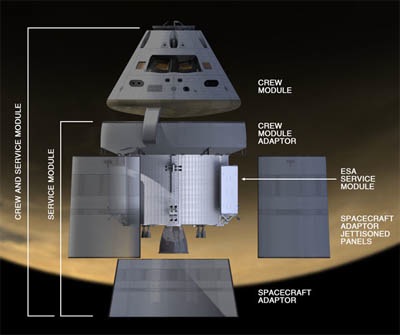
Orion spacecraft's critical engine and power element is now on track for May after a six-month delay to contend with weight issues. With a height and diameter of about four meters, or 13 feet, the service module is based on Europe's flight-proven Automated Transfer Vehicle, a robotic resupply spacecraft that has flown four times to the International Space Station.
The 2017 flight, known as Exploration Mission 1, is planned to conduct a lunar fly and enter a so-called "distant retrograde orbit" about 43,000 miles from the moon.
The 2017 test flight, planned to last more than three weeks, will be a pathfinder for NASA's asteroid redirect mission, an effort to send a robotic spacecraft into deep space and guide a 500-ton rock to a stable location near the moon for visits by human crews aboard the Orion spacecraft.
Offline
Like button can go here
#364 2014-05-20 20:56:43
- SpaceNut
- Administrator
- From: New Hampshire
- Registered: 2004-07-22
- Posts: 30,271
Re: Orion (CEV / SM) - status
With the increased vocal drawbacks as stated by Russia for the ISS , the engine maker for Atlas: NASA may bring Orion's test flight forward to September. The unmanned mission, dubbed Exploration Flight Test-1 (EFT-1),will see an unmanned but pressurized Orion vehicle lifted into orbit by a United Launch Alliance Delta IV Heavy scheduled for December this year. It was put back three months from the original target date to make way for the launch of military surveilance satellites for the US Air Force.
The Orion test vehicle consists of five elements which will be evaluated. Orion will orbit Earth twice at an altitude of 3,600 miles (about 5,800 km) then return through Earth's atmosphere at a speed of about 20,000 mph to test the heatshield in which it will encounter temperatures of up to 4,000 degrees Fahrenheit on re-entry.
Offline
Like button can go here
#365 2014-05-21 20:15:45
- SpaceNut
- Administrator
- From: New Hampshire
- Registered: 2004-07-22
- Posts: 30,271
Re: Orion (CEV / SM) - status
Lockheed Martin Is Seeking To Americanize Orion’s European Service Module
Now, for financial reasons, ESA prime contractor Airbus Defence and Space may provide only “one and a half” service modules, Larry Price, Lockheed’s Orion deputy program manager, said in an interview here.
“They may not complete both of them, depending on funding,” Price said. But “we think we can drive Europe’s cost down so they can deliver two complete service modules” by steering the European company toward American suppliers already working on the Orion crew module. “If we use common parts, they can be lower price,” Price said. He added that ESA is set to deliver a full service module for the 2017 flight. Because of U.S. export control regulations, and the fact that Lockheed has no contractual authority over the European service module, the company has had to tread “very carefully” in its interactions with Airbus, which are nevertheless ongoing, Price said.
Good old ITAR...even with friendly nations that we call friend and Partners....
Last edited by SpaceNut (2014-05-21 20:39:59)
Offline
Like button can go here
#366 2014-05-21 20:30:14
- RobertDyck
- Moderator
- From: Winnipeg, Canada
- Registered: 2002-08-20
- Posts: 8,353
- Website
Re: Orion (CEV / SM) - status
Good old ITAR...even with friendly nations that we call friend and Partners....
Hear Hear!
Offline
Like button can go here
#367 2014-05-22 00:08:08
- Midoshi
- Member
- From: Colorado
- Registered: 2007-07-14
- Posts: 157
Re: Orion (CEV / SM) - status
SpaceNut wrote:Good old ITAR...even with friendly nations that we call friend and Partners....
Hear Hear!
Indeed. I'm in Europe for a meeting with colleagues right now, and we Americans seriously had to consider the possibility that we dismiss our hosts from the room at one point due to ITAR. Ridiculous.
"Everything should be made as simple as possible, but no simpler." - Albert Einstein
Offline
Like button can go here
#368 2014-11-07 21:10:20
- SpaceNut
- Administrator
- From: New Hampshire
- Registered: 2004-07-22
- Posts: 30,271
Re: Orion (CEV / SM) - status
Orion launch to test human flight risks in deep space
No one will be on board when Orion launches next month from Cape Canaveral in Florida, but the test will involve more than $370 million in rocket equipment and hardware.
That price tag does not include the cost of building the gumdrop-shaped Orion multi-purpose crew vehicle, built by Lockheed Martin to carry people into deep space.
The test mission, known as EFT-1, is scheduled to blast off December 4 at 7:05 am (1205 GMT) from a NASA launchpad at Kennedy Space Center. It aims to end with an ocean splashdown about four and a half hours later.
The rocket will be strapped with two boosters offering 663,000 pounds (301,000 kilograms) of thrust each,
Offline
Like button can go here
#369 2014-12-03 21:31:13
- SpaceNut
- Administrator
- From: New Hampshire
- Registered: 2004-07-22
- Posts: 30,271
Re: Orion (CEV / SM) - status
Live coverage: Orion’s first space mission
T-minus 9 hours 30 minutes and counting. The countdown has commenced for tomorrow's launch of the Delta 4-Heavy rocket. With 30 minutes of planned hold time built into the count, liftoff remains set for 7:05 a.m. EST (1205 GMT).
Offline
Like button can go here
#370 2014-12-09 22:00:02
- SpaceNut
- Administrator
- From: New Hampshire
- Registered: 2004-07-22
- Posts: 30,271
Re: Orion (CEV / SM) - status
Upcoming SLS/Orion Hearing
House Science Committee Hearing: Update on the Space Launch System and Orion
Offline
Like button can go here
#371 2014-12-16 22:32:48
- SpaceNut
- Administrator
- From: New Hampshire
- Registered: 2004-07-22
- Posts: 30,271
Re: Orion (CEV / SM) - status
Estimated Cost of 3 NASA Exploration Programs to Exceed $21 Billion: GAO
The three human exploration programs include the Space Launch System (SLS) vehicle, the Ground Systems Development and Operations (GSDO), and the Orion Multi-Purpose Crew Vehicle (Orion).
The SLS, GSDO and Orion missions represent NASA's largest exploration investment over the next decade, approaching some $23 billion.
"NASA estimates SLS will cost 9.7 billion through the first flight test in 2018. NASA estimates GDSO will cost 2.8 billion for the same time period. NASA does not yet have official estimates for Orion, but it had a preliminary estimate of 8.5 billion to 10.3 billion to the second flight test," GAO's acting director of the acquisition and sourcing management team, Cristina T. Chaplain, told Sputnik Thursday.
November 2018 launch date for GSDO and SLS with a 70 percent confidence level in that date
Offline
Like button can go here
#372 2015-02-21 19:27:33
- SpaceNut
- Administrator
- From: New Hampshire
- Registered: 2004-07-22
- Posts: 30,271
Re: Orion (CEV / SM) - status
Engineers finding lessons in nearly flawless Orion test flight
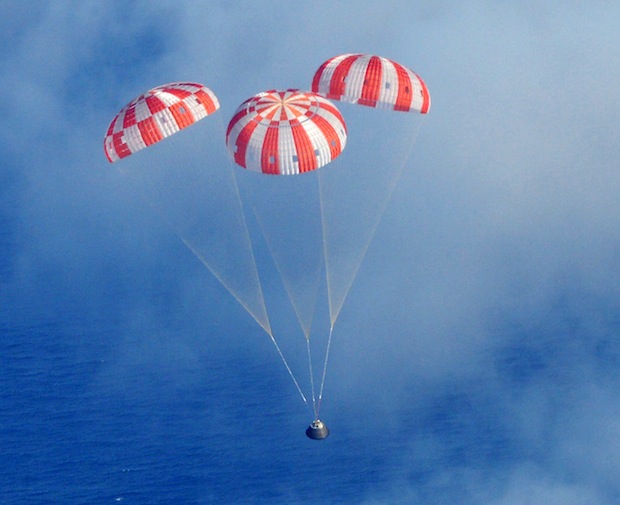
The EFT-1 flight in December launched on a United Launch Alliance Delta 4-Heavy rocket and splashed down in the Pacific Ocean west of Mexico.
The Orion spacecraft descends under three main parachutes at the end of its first mission into space Dec. 5. December’s first orbital test flight of NASA’s Orion crew capsule was almost perfect, but engineers are carefully analyzing 600 gigabytes of data recorded on the spacecraft’s trip 3,600 miles into space to see how future missions to an asteroid and Mars could be improved.
The data crunch will take much of the year, ultimately feeding into design tweaks and recommendations at a major Orion program review in the fourth quarter of 2015.
The 2018 flight is named Exploration Mission-1, or EM-1, and will not carry astronauts. The first mission with a crew is scheduled for 2021 on the EM-2 flight. The EM-1 and EM-2 flights will go around the moon, and the crewed mission will be the farthest voyage by astronauts since the last Apollo lunar landing in 1972.
Offline
Like button can go here
#373 2015-07-26 16:06:48
- SpaceNut
- Administrator
- From: New Hampshire
- Registered: 2004-07-22
- Posts: 30,271
Re: Orion (CEV / SM) - status
While searching to answer why the Orion Avocoat heatshield would not be capable of a Mars return this image was located.
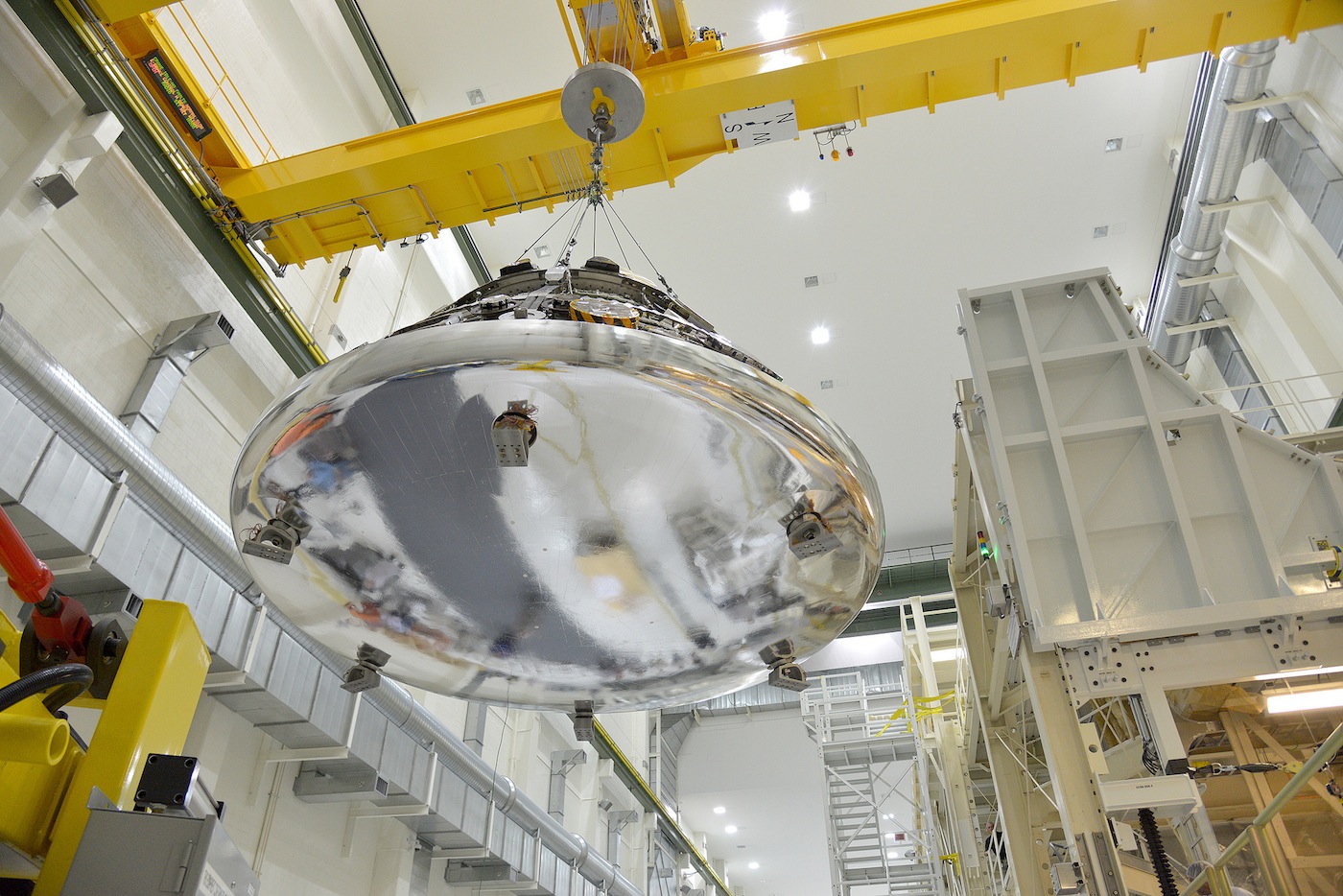
The heat shield is covered in a reflective silver tape that protects it from the extreme cold temperatures of space.
The heat shield can endure temperatures of up to 4,000 degrees Fahrenheit, conditions the Orion capsule would see when returning from deep space missions to the moon, asteroids or Mars.
That said I think the reason for it not being the soul manned vehicle for a mars return lays in the remaining comment of its cramp for use beyond 2 weeks, lacking in artificial gravity due to small size ect...
Offline
Like button can go here
#374 2015-07-26 16:17:14
- SpaceNut
- Administrator
- From: New Hampshire
- Registered: 2004-07-22
- Posts: 30,271
Re: Orion (CEV / SM) - status
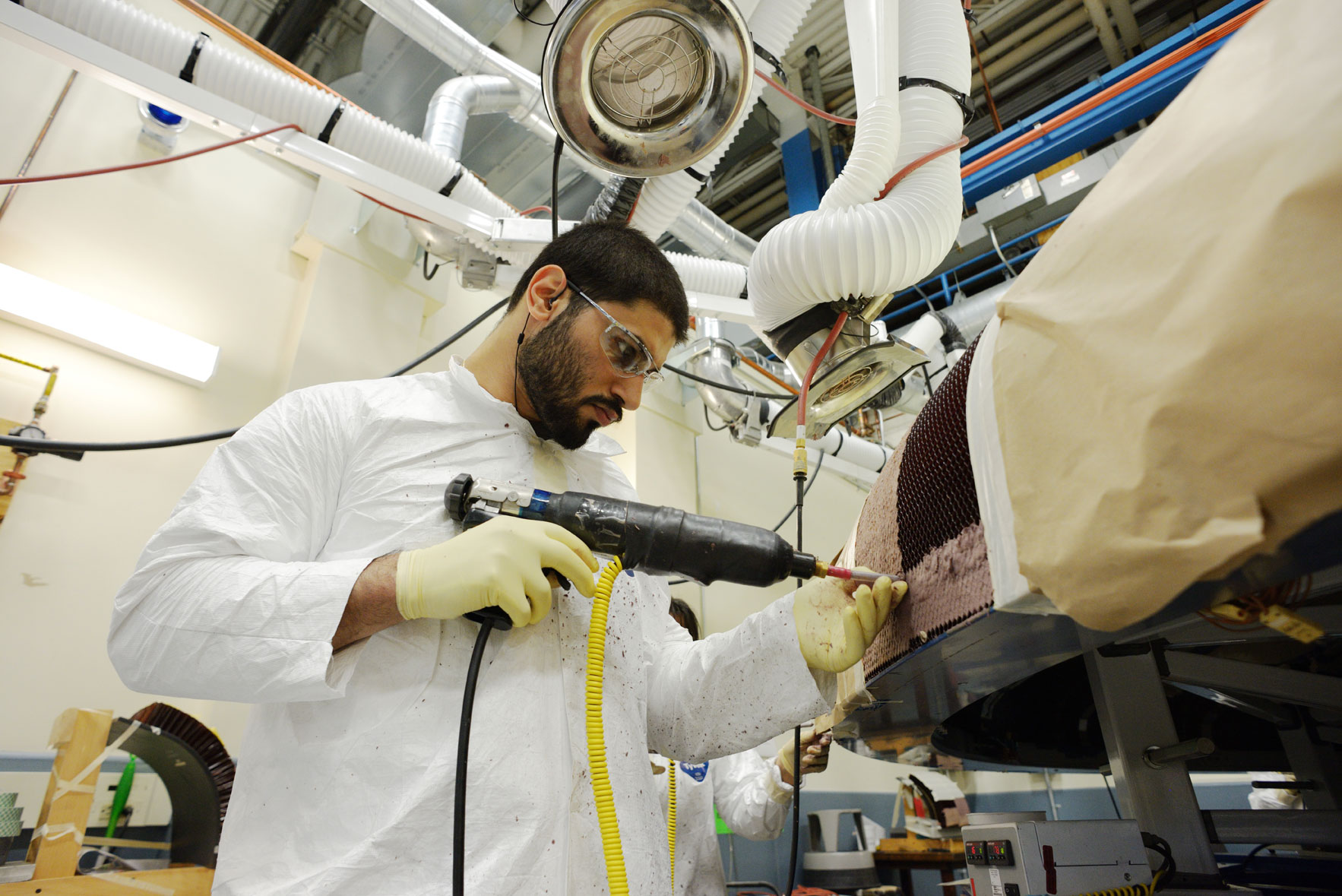
The Orion heat shield’s titanium skeleton and carbon fiber skin was fabricated by Lockheed Martin — the craft’s prime contractor — in Colorado. The skeleton was shipped to Textron Defense Systems in Massachusetts for installation of a fiberglass-phenolic honeycomb structure.
More than 330,000 individual cells make up the honeycomb, and Textron technicians — using a special dispensing gun — filled the cells by hand with a material called Avcoat.
Now that is time consuming.....
Offline
Like button can go here
#375 2015-09-16 12:16:41
- RobertDyck
- Moderator
- From: Winnipeg, Canada
- Registered: 2002-08-20
- Posts: 8,353
- Website
Re: Orion (CEV / SM) - status
Just listened to an update.
NASA to Hold Teleconference to Discuss Orion Spacecraft Progress
A couple interesting statistics. Total cost including flights EM1 & EM2 will be $6.77 billion.
EM-2 is scheduled for April 2023.
EM-1 will fly a retrograde orbit about the Moon. Tests will focus on the service module.
EM-2 will focus on interaction with crew, including life support systems.
Heat shield has been changed. Instead of monolithic AVCOAT it's now blocks.
Orion can support 4 crew up to 21 days.
Offline
Like button can go here